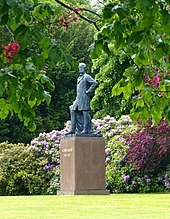Alfred Krupp monument (Krupp cast steel factory)

The Alfred Krupp memorial was located between 1892 and 1945 at the entrance to the Krupp cast steel factory in what is now the western quarter of the city of Essen and commemorated the industrialist Alfred Krupp who made the Krupp cast steel factory founded by his father Friedrich Krupp into the largest industrial company in Europe at the time Friedrich Krupp AG , which was merged into today's ThyssenKrupp AG in 1999 .
The Alfred Krupp statue was thrown from its base in 1945 by Allied bombs . This original was installed in the Hügelpark in 1962 and replaced by a replica in 1999. The original is now in the possession of the Ruhr Museum .
history

After the Alfred Krupp monument at the Marktkirche, the monument is the second to represent Alfred Krupp in a similar way. It stood in front of the 8th mechanical workshop, roughly where the outer staircase of the hall converted into the Colosseum Theater is today. Here, on Limbecker Chaussee (today Altendorfer Straße), between the 8th mechanical workshop and the East Press and Hammer Works , was the representatively designed main entrance area to the cast steel factory, the so-called Krupp city, which at that time took up a significantly larger area than the the actual city of Essen to the east. This area roughly forms today's western quarter of the city of Essen.
The Alfred Krupp monument was donated by his company's staff and created by the Munich sculptors Alois Mayer and Josef Wilhelm Menges. In 1892 it was unveiled by workers at the entrance to the cast steel factory. Krupp is shown in his riding suit, which is his favorite for everyday life, as he was known in Essen above all on horseback, riding along the dirt road between his residence Villa Hügel and the cast steel factory. The memorial shows his left hand on his hip, the right holding his hat, gloves and coat.
The bronze - statue stood on a stone base, was played on the Krupps guiding principle inscribed he occasion of the 25th anniversary of his assumption of the leadership of the cast steel factory by his mother in 1873 Therese Krupp devised:
"The purpose of work should be the common good, then work brings blessings, then work is prayer."
To the right of the base was the figure of a worker widow who, with her child , was supposed to point out the social and human side ( humanitas ) of the company. This woman was holding a laurel branch and a roll of parchment in her right hand, on the unrolled sheet of which were Goethe's words:
"Let man be noble, helpful and good!"
To the left of the stone plinth sat the bronze figure of a blacksmith with a railway wheel and cannon barrel, symbolizing the work and showing off the most successful products. The entire monument was of a fence surrounding it.
As a thank you for the memorial, Alfred Krupp's son Friedrich Alfred Krupp had the Altenhof settlement built for Krupp elderly and disabled people.
Web links
Individual evidence
- ^ Route of Industrial Culture - Colosseum Theater ( Memento from January 2, 2014 in the Internet Archive ); Retrieved April 18, 2013.
